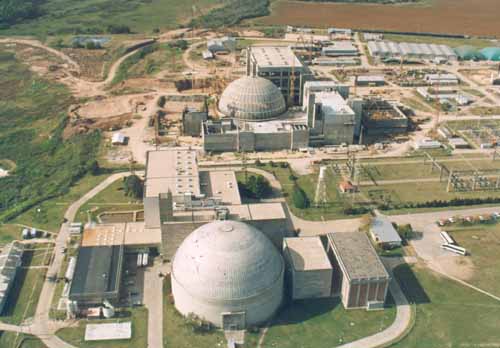The Antinuclear Movement of the Argentine Republic (MARA) has described as “unusual and unethical” the children’s campaign on nuclear heroes promoted by Nucleoeléctrica Argentina Sociedad Anónima (NASA). It did so through a document in which the Foundation for the Defense of the Environment (FUNAM), an NGO member of MARA, participated technically.

NASA reportedly called on the girls and boys who live in the vicinity of the Atucha I and Atucha II nuclear power plants in the province of Buenos Aires, and Embalse in the province of Córdoba, to send them drawings of nuclear heroes fighting the coronavirus.
MARA considered that “any campaign aimed at increasing prevention against the SARS-CoV-2 virus and the disease it produces, COVID-19, is welcome. But it adds that NASA “lacks ethics to address girls and boys who live near nuclear power plants because their activities routinely and accidentally discharge low doses of radioactive materials that can affect the health of these children. The three reactors in operation also represent the worst technological risk for current and future generations, even when they stop operating.”
The members of MARA wondered “what is the sense of relating nuclear heroes and coronavirus, when the best fight is the one carried out by ordinary girls, boys and adults doing social isolation and maintaining adequate hygiene conditions. This ambiguous characterisation only leads to confusion, supposedly to improve the battered image of NASA and the Argentine nuclear sector “.
Dr. Raúl Montenegro, president of FUNAM and member of MARA, recalled that “in the hypothetical case that any of the nuclear power plants suffers the worst nuclear accident or event, the so-called Level 7 on the INES scale, they could be affected the health of people and the environment within a radius of 500 kilometers around each damaged reactor.
“Worse still, the highly radioactive waste left by the unsafe operations of the three nuclear power reactors in Argentina is stored in vulnerable deposits that remain at risk for more than 240,000 years (1). A true nightmare. When they stop operating the three plants, their highly radioactive deposits will be dangerous for millennia.
“It is enough for a large commercial aircraft to hit, for example, the silos park of the Embalse nuclear power plant, where the highly radioactive spent nuclear fuel is stored, for an event equivalent to several Chernobyl to occur. Every year there are more silos, more highly radioactive spent fuel, and more risk.”
Silvana Buján from BIOS, another of the organisations that make up MARA, said that NASA “never bothered to prepare families who live up to 500 kilometres from each nuclear power plant, and that they could suffer the effects of a hypothetical worst accident or event. For years they have been doing poor drills for minor nuclear accident about 10 kilometres around each nuclear power plant. The families of the children who lived and live outside this 10 kilometre radius were never informed of the risks, nor prepared. “
FUNAM also pointed out that in the past there were “organised visits by primary school students to nuclear power plants, which is an aberration because any power plant can suffer an extremely serious accident or event. No educational authority would allow its students and Students will visit the facilities of a fully functioning petrochemical complex in Campana or the city of Río Tercero, but they have allowed such visits to nuclear reactors. Government areas of education must review this absurdity so that health and life are not risked of girls and boys. If they don’t they will be co-responsible.”
Agustín Saiz of the Zárate-Campana Antinuclear Movement, a collective member of MARA, recalled that “in the Ministry of Health of Ukraine, of the 2,397,863 people registered to receive medical treatment as a result of the Chernobyl accident, a total of 453,391 are girls Although these children were not born in the area of the accident that occurred in 1986, their parents – who were children at the time – suffered the effects of radioactive contamination. Today, these 453,391 girls and boys suffer from genetic abnormalities, malformations, cancer and other pathologies. We do not want this to happen to us in Argentina. The campaign of nuclear heroes promoted by Nucleoeléctrica Argentina is a dangerous and sinister mockery. “
MARA recalled that if something characterises the nuclear industry in Argentina and other countries, “it is the chronic concealment of its very serious risks, keeping accidents secret and providing falsely reassuring information. It is usual that they repeat that Routine discharges of radioactive materials into the environment comply with current regulations, falsely maintaining that such discharges are harmless.
“The population should know that there is no harmless value of ionizing radiation – ionizing radiation is that released by radioactive materials. Any value is risk as clearly established by the Academies of Sciences, Engineering and Medicine of the United States in document BEIR VII Second Phase”.
“If Nucleoeléctrica Argentina Sociedad Anónima wants to do something for the children of Argentina, it must tell the truth, and prepare those girls, boys and their families — who live within a radius of 500 kilometers around each nuclear power plant — so they can act before a possible local Chernobyl,” indicated Fabiana Vega del MAR, another group of MARA.
In a reaction, Nnimmo Bassey, Director, Health of Mother Earth Foundation (HOMEF), said: “It shows why Nigeria should not toy with nuclear power stations. Imagine the wastes remaining active for thousands of years! And 500km radius over which people would be at risk if a nuclear accident happens.
“If such happens at Itu in Akwa Ibom State, it means the entire state would be unsafe. And all of the Niger Delta. It would reach Lokoja in Kogi State and Douala in Cameroon. Any siting of a nuclear plant in Nigeria is the contruction of a horrible nightmare.”
